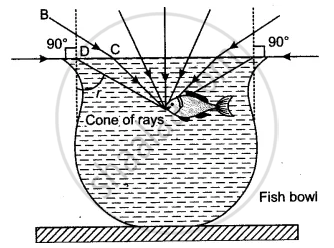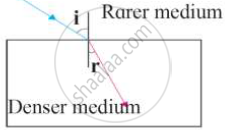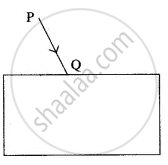Advertisements
Advertisements
प्रश्न
Explain with the help of a diagram of how fish is able to see the objects above it.
उत्तर
A fish can see everything above it in clear water irrespective of its position in different depths. The critical angle for water is 48.5°. The angle of the cone of vision for the fish is twice this angle.

Hence it is 97°. All the objects outside water but in this cone of vision Will be seen by the fish. Outside this range, the fish will see all the objects in the surrounding area (see figure). Those objects which are at the bottom will be seen by the fish due to total internal reflection taking place at the water-air interface.
APPEARS IN
संबंधित प्रश्न
Name one factor that affects the lateral displacement of light as it passes through a rectangular glass slab.
The speed of light in glass is 2 × 105 km/s. What is the refractive index of glass?
How does the angle of deviation produced by a prism change with increase in the angle of incidence. Draw a curve showing the variation in the angle of deviation with the angle of incidence at a prism surface.
How is the angle of emergence related to the angle of incidence when prism is in the position of minimum deviation? Illustrate your answer with help of a labelled diagram using an equilateral prism?
An object is viewed through a glass prism with its vertex pointing upwards. It appears to be displaced upward. Explain the reason.
Observe the figure and write accurate conclusion regarding refraction of light.

A ray of light strikes the surface at a rectangular glass slab such that the angle of incidence is 45o.
In each case, draw diagram to show the path taken by the ray as it passes through the glass slab and emerges from it.
Glass is transparent in nature. Why does glass powder look opaque? When water is poured over it, it again becomes transparent. Why?
In the diagram below, PQ is a ray of light incident on a rectangular glass block.

Copy the diagram and complete the path of the ray of light through the glass block. In your diagram, mark the angle of incidence by letter ‘i’ and the angle of emergence by the letter ‘e’.
